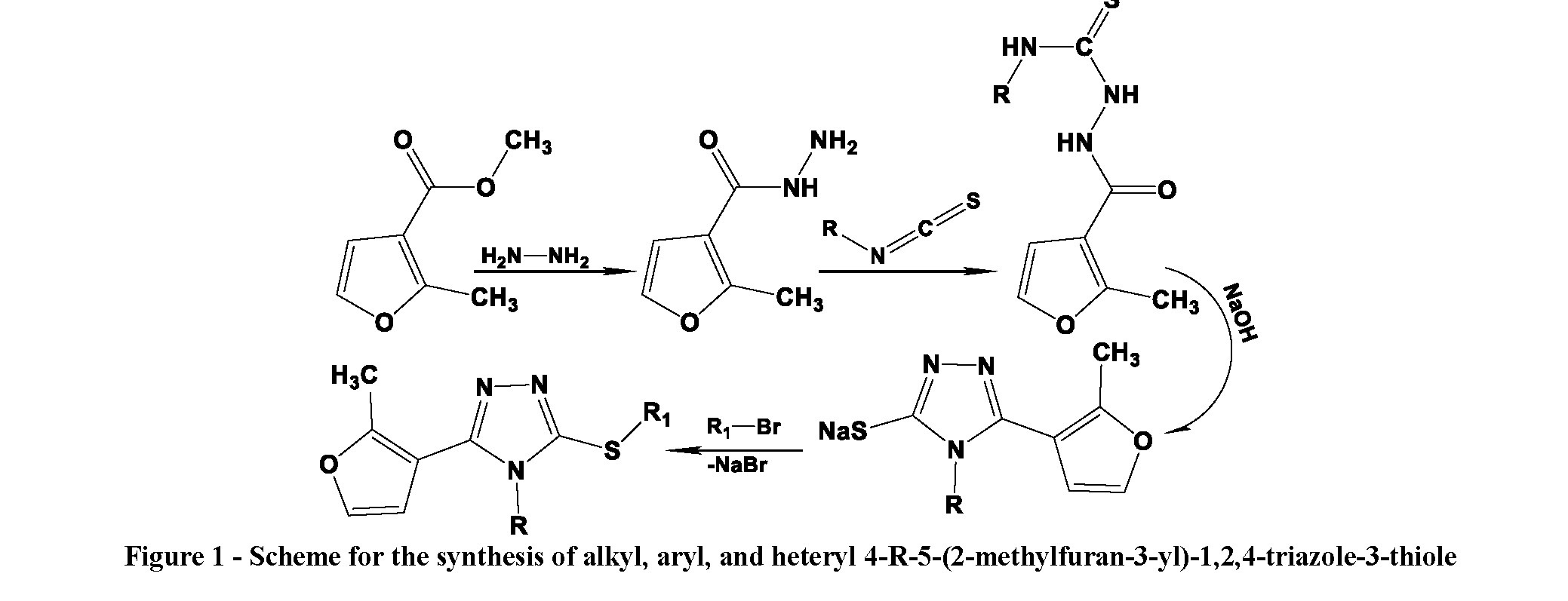Topicality. An analysis of scientific sources has shown that heterocyclic compounds are the most widespread group of organic compounds. The main part of them shows rather pronounced biological activity. Not paying attention to a wide range of medicines claimed in the modern market, the search for new biologically active substances has not lost its relevance [1;4]. Particular attention is paid to compounds formed with the participation of interesting heterocyclic systems, for example: 1,2,4-triazole, furan and their derivatives, performing the typical function of pharmacophores [2;3;5].
The purpose of the work was to synthesize and investigate the properties of compounds, which in its composition combine two heterocyclic fragments: 2-methylfuran and 1,2,4-triazole.
Materials and methods. As the starting material, methyl ester of 2-methylfuran-3-carboxylic acid was used. We obtained 4-R-5-(2-methylfuran-3-yl)-1,2,4-triazole-3-thiole through a series of successive reactions (hydrazinolysis, nucleophilic attachment, and intermolecular alkaline heterocyclicization). The thiole was reacted by alkylation with

halogens. The structure and individuality of the synthesized compounds were confirmed by modern physico-chemical methods of analysis: 1H NMR spectroscopy, IR-spectroscopy, UV-spectrophotometry, elemental analysis and chromatomass-spectrometry. Using the computer web resource "GUSAR Online" predicted the low toxicity of the compounds obtained.The study of biological activity was carried out by serial dilutions on the clinical tests of C. albicans, P. aeruginosa, E. coli and S. aureus strains.
Results and discussion. 15 Derivatives of 4-R-5-(2-methylfuran-3-yl)-1,2,4-triazole-3-thiole were synthesized. The structure of synthesized compounds is confirmed. Antimicrobial activity was studied and probable toxicity of the obtained substances was predicted.
Conclusions. As a result of the work, 15 derivatives of 4-R-5-(2-methylfuran-3-yl)-1,2,4-triazole-3-thiole have been obtained. Studies of antimicrobial activity have demonstrated the presence of high sensitivity to E. coli in the synthesized compounds. The computer simulation of acute toxicity allows us to conclude that the future of experimental studies of synthesized compounds is promising.
References
- El-Sherief A. M. H. Synthesis, anticancer activity and molecular modeling studies of 1,2,4-triazole derivatives as EGFR inhibitors / H. A. M. El-Sherief, B. G. M. Youssi, B. Syed Nasir Abbas // European Journal of Medicinal Chemistry. - 2018. - P. 774-789.
- Mohamed Sayed S. Synthesis of pyrazole, 1,3-dithiolan and thiophene derivatives pendant to thiazolo[2,3-c]- 1,2,4-triazole moiety / S. Mohamed Sayed, A. Mohamed, R. Mohamed Abd-Elmonem // European Journal of Chemistry. - 2014. - №5. - P. 356-362.
- Pyrrole pincers containing imidazole, pyrazole and 1,2,4-triazole groups / [K. Lin, C. Love-Ese, S. Cuichang Zhen et al.]. // Inorganica Chimica Acta. - 2014. - P. 95-101.
- Recent Developments on 1,2,4-Triazole Nucleus in Anticancer Compounds / [K. Ramandeep, R. Dwivedi Ashish, K. Bhupinder et al.]. // Anti-Cancer Agents in Medicinal Chemistry. - 2016. - P. 465-489.
- Synthesis, antioxidant and analgesic activities of Schiff bases of 4-amino-1,2,4-triazole derivatives containing a pyrazole moiety / [K. Karrouchi, L. Chemlal, J. Taoufik et al.]. // Annales Pharmaceutiques Frangaises. - 2016. - P. 431-438.